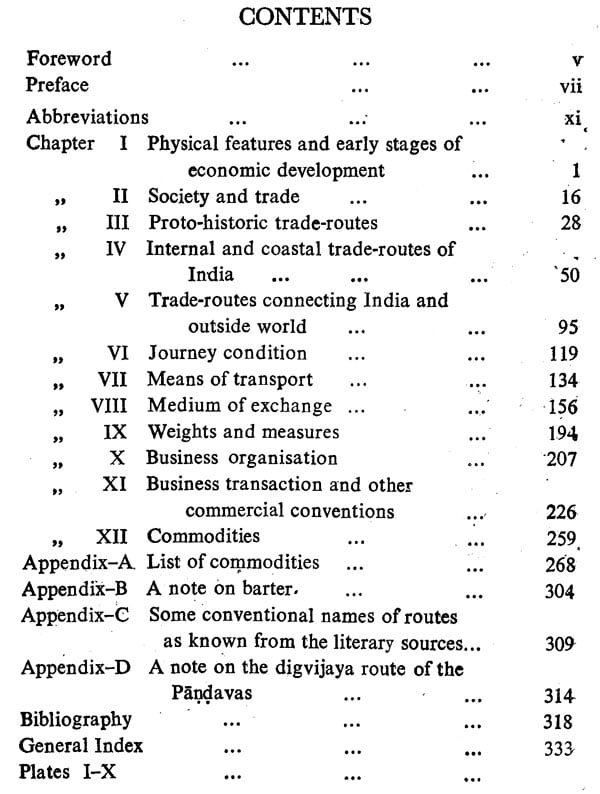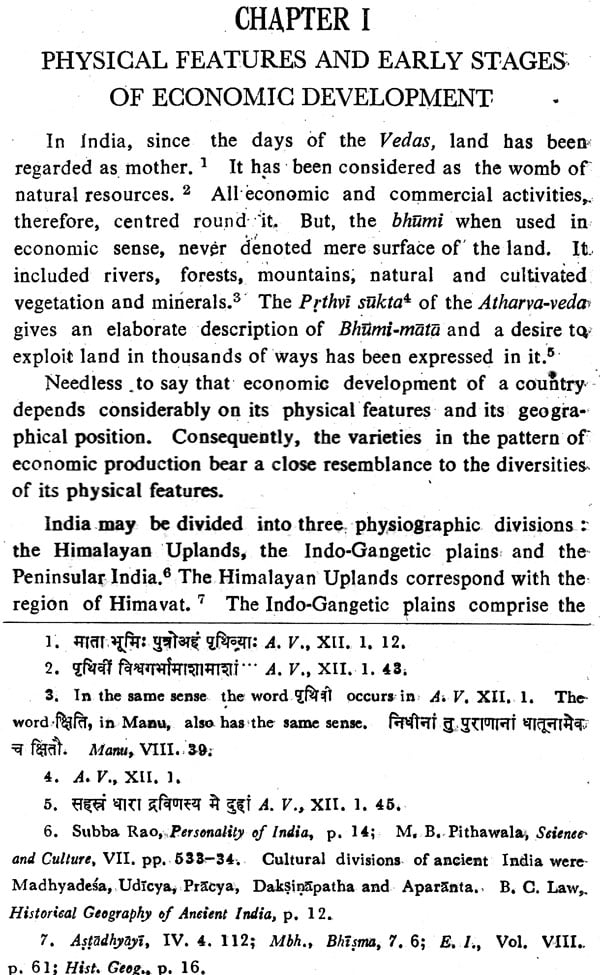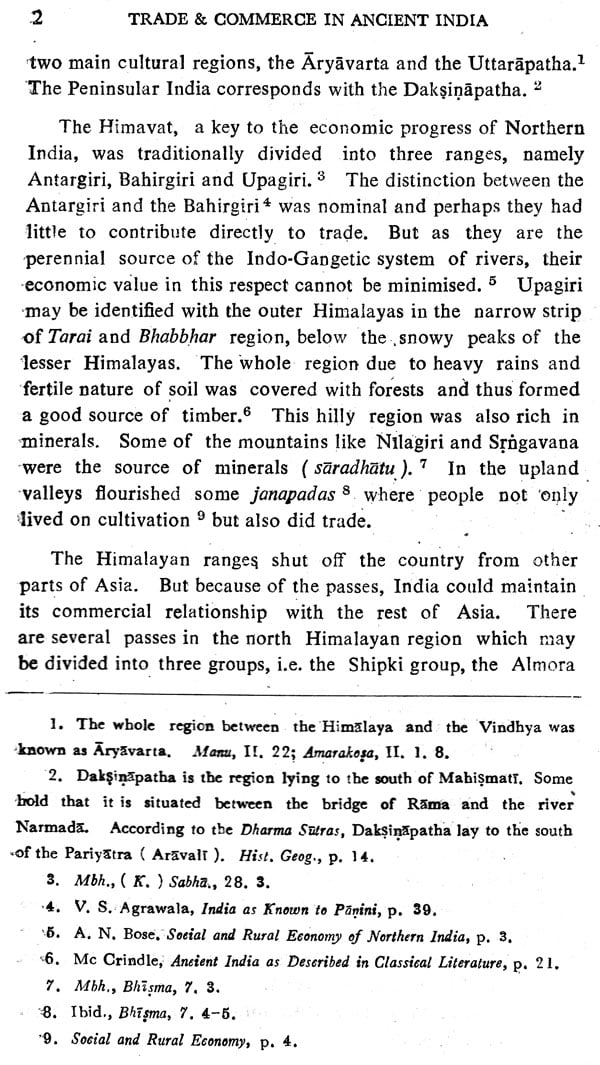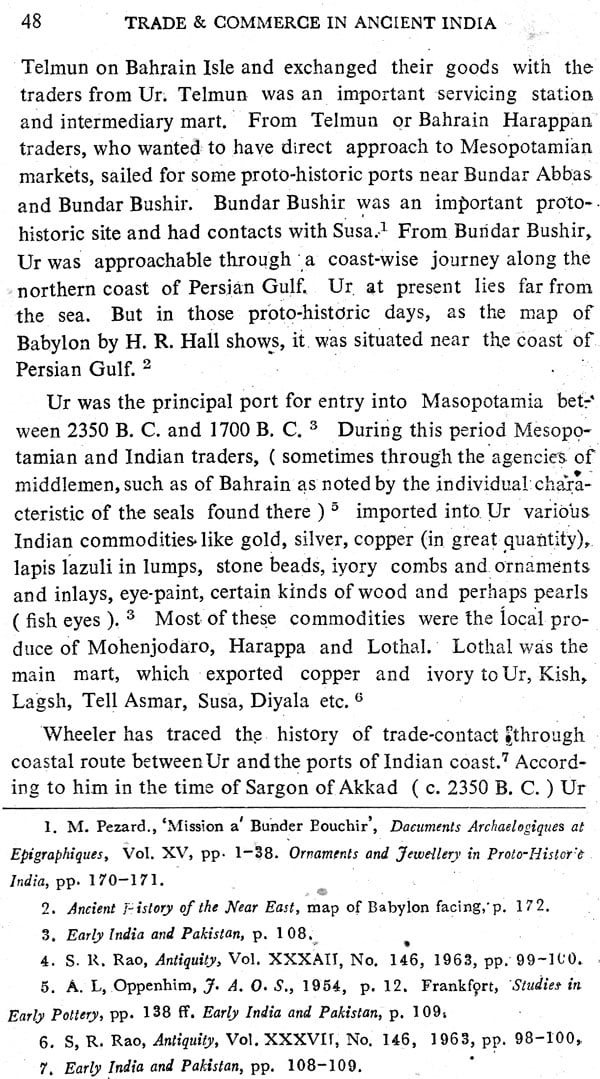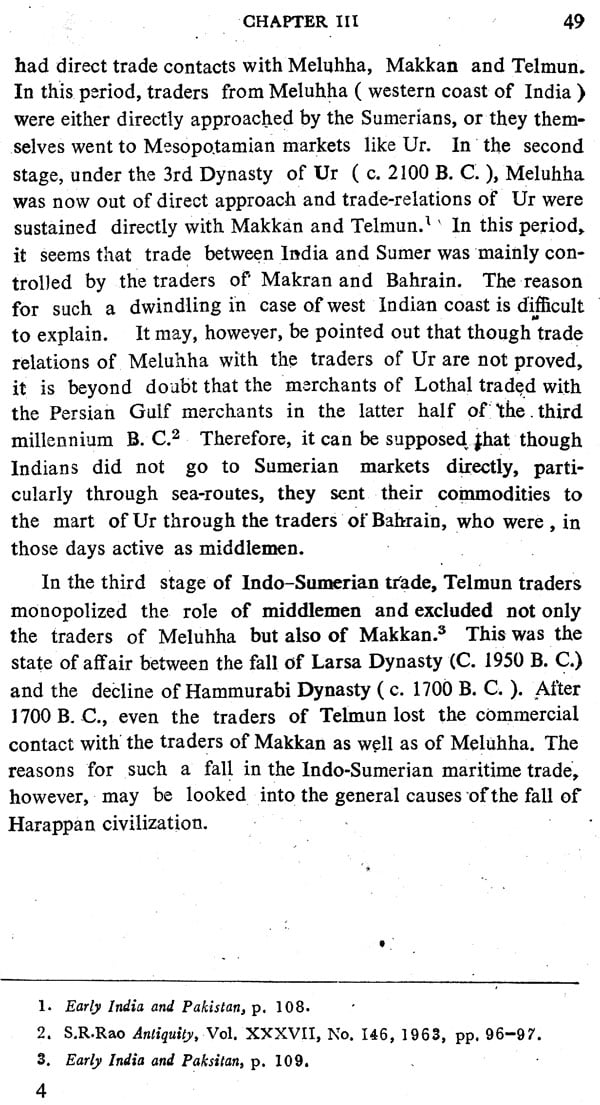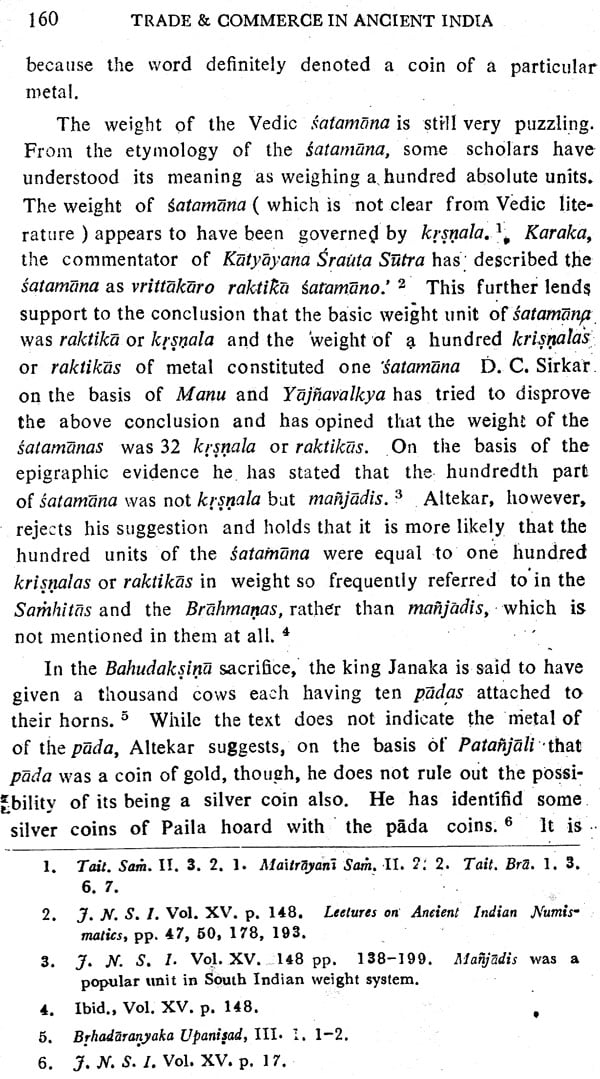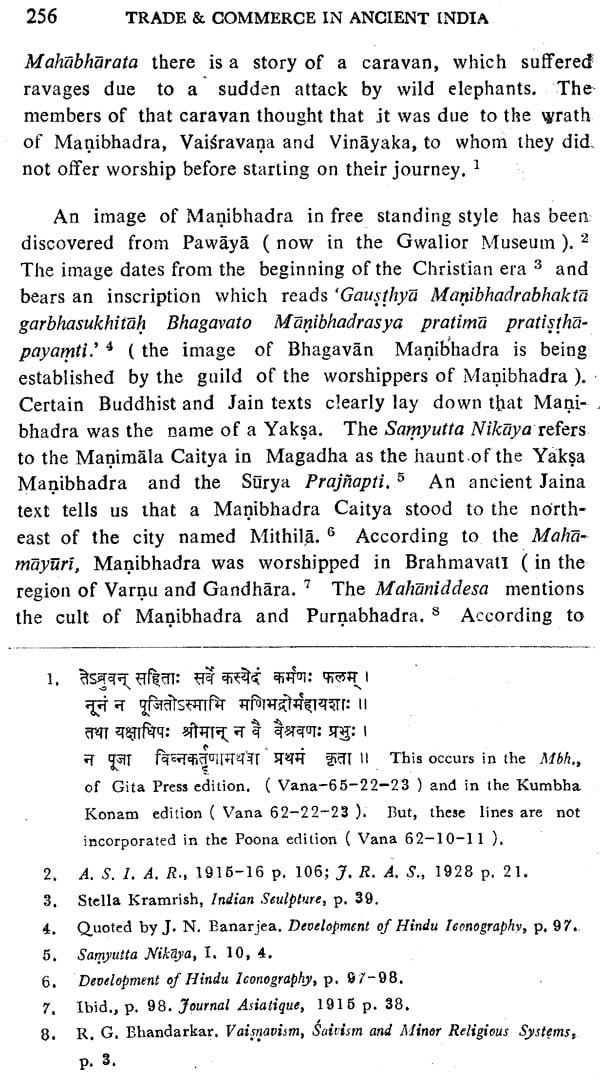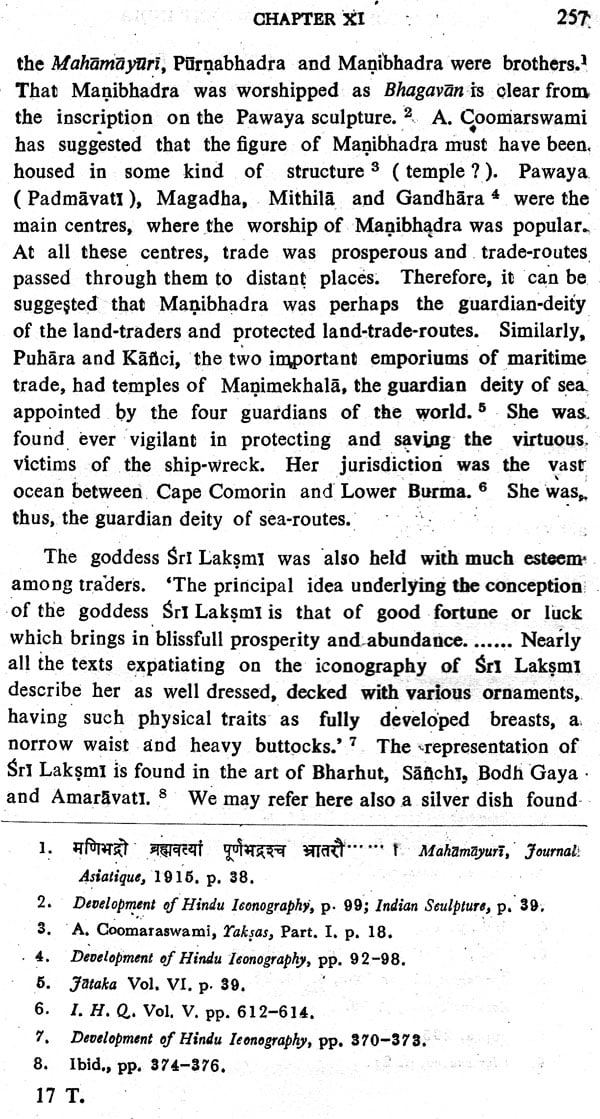
Trade and Commerce in Ancient India- From the Earliest to C. A.D. 300 (An Old and Rare Book)
Book Specification
| Item Code: | NAU842 |
| Author: | Balram Srivastava |
| Publisher: | Chowkhamba Sanskrit Series Office |
| Language: | English |
| Edition: | 1968 |
| Pages: | 363 (Throughout B/W Illustrations) |
| Cover: | HARDCOVER |
| Other Details | 8.50 X 5.50 inch |
| Weight | 480 gm |
Book Description
From the days of the proto-historic Harappa culture, India. has always been a trading nation, with prized commodities to offer to the world—jewels, spices and fine textiles, steel,, medicinal drugs and perfumes. Her merchants in ancient times were, well known outside India from Alexandria to Canton. Within the sub-continent they were respected members of the community, busily buying and selling throughout the land, journeying in large caravans in search of profit. Many of them strongly supported the heterodox cults such as Buddhism and Jainism, and it is largely to the patronage of the wealthy mercantile community, rather than to that of kings and Ksatriyas, that the development of these two communities is due. The Jain and Buddhist scriptures are replete with references to the pious and wealthy members of the mercantile community, who gave their support to the heterodox religions, and the early votive inscriptions, on stripa railings and in cave temples, tell the same story. Ancient India was not a land of mystics, philosophers and theologians, supported by the subsistence agriculture of millions of simple peasants; neither was India a land where a comparatively small number of brahmans and warriors tyrannized over a servile mass of insignificant cultivators and labourers. At all times there was a significant middle class, mostly engaged in trade and industry, whose wealthier members were influential in the courts of the kings and in the purlieus of the temples.
The sources for the study of these people and their activities, are fragmentary and scattered, and in this respect ancient India is much worse served than, for instance, ancient Babylon, which has left economic documents in such quantity that even now many clay tablets excavated in the last century remain unread. Ancient Indian sources, unfortunately, tell us nothing about fluctuations in the prices of staple commodities and throw very little light on the standard of living of the ordinary man, though there is some evidence to show that he had a rather greater share of the national income than his counterpart in more recent times. Ancient Indian eco-nomic history must inevitably be lacking in detail and precision, and there seems little likelihood that archaeology will bring to light a body of new written material to illuminate its many obscurities. Nevertheless, by the judicious use of a wide range of sources it is possible to present a broad outline of the development of early Indian economic life. Seveial , efforts have already been made in this direction, with varying success. The inadequacy of the material has led many scholars to read too much into their sources, to base ambitious theories on the dubious interpretation of a single word or phrase, to extrapolate the data of any given text as valid for all regions' and periods. Dr. Balram Srivastava has avoided most of the pitfalls which trapped many earlier students of the subject. He has carefully re-examined the sources for the- economic history of India down to the days of the Periplus, when the trade with Rome was at its height, and, has checked their data as far as possible with archaeological evidence, which since the second World War has appeared in increasing quantity, and which, though it produces little significant written material, is gradually adding another dimension to our picture of India's past. Thus Dr. Srivastava has made an important contribution to our knowledge of ancient India, which deserves the attention of all students of the subject. I am delighted to have been given the privilege of introducing his book to the world.
As trade is an index of culture, this important aspect of study in the field of Indology has been receiving attention of scholars since the closing decades of the nineteenth century A. D. The important land-marks of the researches of this aspect of Indian culture are represented by the works of J. Kennedy, Mrs. Rhys Davids, R. K. Mookerji, N. C. Bandyo-padhyaya; J. N. Safnaddar, Pran Nath, M. A. Buch and A. N. Bose. Some of the general works, mostly devoted to the Buddhist sources, such as those of Richard Fick, B. C. Law and R. L. Mehta also significantly contribute to the study of trade-activities of the past. The monograph of E. H. War-mington, `The. Commerce between the Roman' Empire and India' is a classic on the history of trade and commerce of India and represents successfully the western point of view, being mostly based on the Greek and Roman literature. ,Besides, we may also refer as important contibutions in this field to some of the recent works of Motichandra, K. D. Bajpai, G. L. Adhya and H. Chakraborti.
While selecting the topic for the present work, I was not only aware of the importance and the value of the subject but also inspired by the writings of the above mentioned scholars. I take this opportunity to express my indebtedness to all such scholars who have contributed directly or indirectly in this field and whose labour has obviously offered an advantage to me. As one has to cast his net very wide to collect the material for such studies from diverse sources, I have taken only the main aspects of trade and commerce of ancient India and have limited my investigation from the earliest times up to circa 3rd century A. D., thus covering the period from the pre-history representing the beginnings of trade and the other economic activities to nearly the final phase—Indo-Roman trade. For this period, the sources tapped for the study are mostly literary as well as archaeological and they not only provide material for the reconstruction of the history of trade and commerce of the period in general but of its institutions, organisations, and elements also. This work substantially represents my thesis, which I pre-pared in 1963 for the Ph. D. degree of Banaras Hindu Univer-sity, under the supervision of Professor A. K. Narain. I res-pectfully acknowledge all kinds of help and guidance that. I received from him. 1 am thankful to Professor A. L. Basham who has kindly written the foreword for this book. While the work was in progress, I have been variously helped by Dr. Rai Govinda Chandra and Dr. L. Gopal and I am indebted to them. I am also thankful to the friendly assistance of Sri Krishna-- charya and Sri S. N. Khanna of National Library of Calcutta, Sri Balram Bharadwaj of Saraswati Bhavan Library, Sanskrit University, Varanasi, Sri S. C. Ghildayal and B. N. Pathak of the library of College of Indology, Banaras Hindu Univer-sity. My thanks are also due to Sri L. P. Mishra for maps, to Sri Bajrangi lal and Sri Madhurji for line drawings. I would like also to express my gratitude to my publishers,. Chowkhamba Sanskrit Series Office.
**Contents and Sample Pages**
